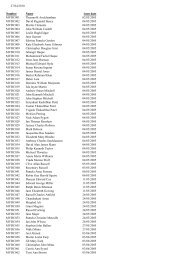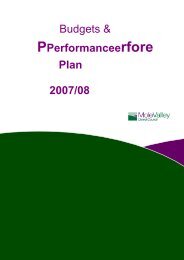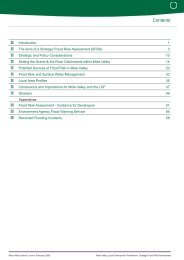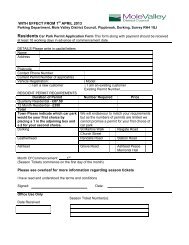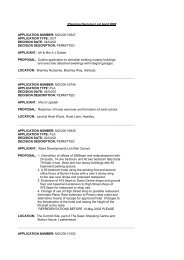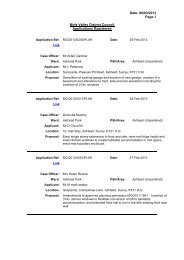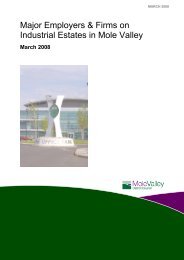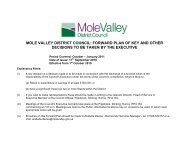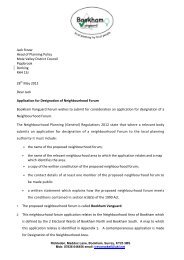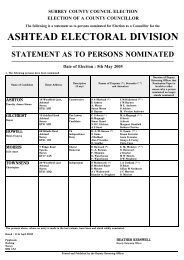MOLE VALLEY NATURAL HISTORY AUDIT BUTTERFLIES
MOLE VALLEY NATURAL HISTORY AUDIT BUTTERFLIES
MOLE VALLEY NATURAL HISTORY AUDIT BUTTERFLIES
Create successful ePaper yourself
Turn your PDF publications into a flip-book with our unique Google optimized e-Paper software.
Mole Valley Agenda 21, Nature Conservation Sub-Group<br />
<strong>MOLE</strong> <strong>VALLEY</strong> <strong>NATURAL</strong> <strong>HISTORY</strong> <strong>AUDIT</strong><br />
<strong>BUTTERFLIES</strong>: Distribution and Status 1995/6<br />
Species:<br />
Silver-spotted Skipper<br />
It is difficult to separate populations of this species, which inhabits a number of small patches of<br />
suitable habitat along the downs, with movement of adults between patches. The Mole Gap probably<br />
acts as a barrier which few individuals cross, with metapopulations on either side. The species is<br />
vulnerable to loss of habitat; these losses may not be detected without careful monitoring by experts<br />
familiar with the requirements of the butterfly, but if available habitat were to fall below a critical level<br />
the entire metapopulation could die out very rapidly.<br />
Codes indicate maximum numbers seen on a single visit: A=1, B=2-9, C=10-29, D=30-99, E=100+.<br />
In 1995/6 the species was breeding in the following places:<br />
Population to west in Guildford Borough at Hackhurst and Colekitchen.<br />
White Downs area. National Trust. (Includes Blatchford Down TQ103487, Old Simms Field<br />
TQ105486, Old Plantation TQ107486, Chalk Quarry to east of road TQ114486, Great Down<br />
TQ117488, Chalkpit Field TQ119489, Wholecombe TQ123492, Lamb Leys TQ124495, Ranges<br />
TQ126495).<br />
Numbers up to C per visit. Currently very heavy rabbit grazing is rendering much Festuca ovina<br />
unsuitable even for this short turf specialist and there is potential for increases if rabbit numbers<br />
decrease, for instance due to Viral Haemorrhagic Disease.<br />
Denbies Hillside National Trust. Small populations in the Big Field TQ135500 (B-C), odd individuals<br />
seen in the Brow TQ146502 and Secretary's Field TQ149502.<br />
Box Hill National Trust. strong populations (C-D) on all grassland areas on north side of Hill, where<br />
Festuca sward is common. Smaller populations (A-B) on Viewpoint slopes and Dukes on the south side,<br />
where there is less Festuca currently in suitable condition.<br />
Mickleham Downs National Trust. TQ180535. Small population (B).<br />
Headley Warren TQ190538 (Private). Medium-sized population in Downs Field (C).<br />
Headley Heath, Chalk Slope area National Trust. TQ195533. Small population in South Paddock and<br />
on Terraces (B).<br />
Brockham Warren TQ198512. SCC. Good population (C) on old chalk workings.<br />
Betchworth Quarry TQ205155 Privately owned landfill area. Unsurveyed population on small<br />
patches of grassland, some inaccessible.<br />
Dawcombe Nature Reserve TQ215525. Currently owned by Smith Kline Beecham and managed by<br />
Surrey Wildlife Trust. Medium population (C) breeding mainly in the two compartments (known as A<br />
and B) at the north end of the reserve.<br />
Buckland Hills TQ228525-TQ233523. Privately owned by Buckland Estates. Population currently low<br />
due to excessive rabbit grazing in parts, and threatened in parts due to scrub/tree growth. Most<br />
threatened part of the Surrey SSS population.<br />
Juniper Hill TQ237520. NT. Population currently low due to excessive rabbit grazing.<br />
Mole Place TQ237522. Small area private land above Juniper Hill. Small pop. (B).<br />
Further population on Colley Hill to East, in Reigate & Banstead Borough.




